
When your door latch’s deadlock plunger isn’t working, it might be due to a few common issues. Whether you’re dealing with a traditional door lock or a more advanced electronic version, the problems can range from simple misalignments to more complicated mechanical failures. Let’s dive into some reasons why your door latch’s deadlock plunger isn’t functioning, and how you can troubleshoot it to get things back on track.
Understanding How a Deadlock Plunger Works
To tackle the problem, it’s essential to understand what a deadlock plunger does. Picture this: when you push down on your door handle, the latch extends to hold the door in place. The deadlock plunger acts like a bouncer at a club—only letting in those who are supposed to be there. When activated, it ensures the latch doesn’t retract, even if someone tries to turn the handle from the outside.
The plunger is usually activated by a key, a thumb turn, or an electronic button in the case of smart locks. When it’s working correctly, it secures your door tightly, preventing any unwanted guests. If it’s not working, your door may not lock at all, which can make your home feel less secure.
Common Issues with Your Deadlock Plunger
You might be wondering what could be causing your deadlock plunger to fail. Here are some common culprits:
- Misalignment: If the door isn’t aligned properly with the frame, it can prevent the plunger from engaging.
- Dirt and Debris: Dust, dirt, or even pet hair can accumulate around the mechanism, causing it to stick.
- Mechanical Failure: Sometimes, internal components wear down over time, leading to malfunction.
Understanding these issues can help you troubleshoot effectively. For instance, if your door seems misaligned, you might notice it sticking or scraping against the frame. That’s often a sign that adjustments are needed.
Troubleshooting Misalignment Problems
If you suspect misalignment is the issue, don’t worry; it’s often an easy fix. Start by checking the door hinges. If they’re loose, tighten them with a screwdriver. You might need to adjust the strike plate, which is the part of the frame the deadlock plunger fits into.
Here’s a step-by-step guide to addressing misalignment:
1. Check Door Movement: Close the door and see if it sits evenly within the frame.
2. Inspect Hinges: Look for any loose screws or damaged hinges.
3. Adjust the Strike Plate: If the strike plate doesn’t line up with the plunger, you may need to reposition it by loosening the screws and moving it slightly.
After making these adjustments, test the lock. If it still doesn’t work, we might need to dig deeper.
Cleaning the Mechanism for Smooth Operation
Sometimes, a little cleaning can do wonders. Over time, dirt and grime build up inside the locking mechanism, preventing it from functioning smoothly. Here’s how to clean it effectively:
1. Gather Supplies: You’ll need a can of compressed air, lubricant (like WD-40), and a soft cloth.
2. Remove Excess Dirt: Use the compressed air to blow out dust and debris from the latch and plunger.
3. Apply Lubricant: Spray a small amount of lubricant into the mechanism but avoid over-saturating it.
4. Wipe Away Residue: Use the cloth to wipe off any excess lubricant for a clean finish.
Regular maintenance can prevent issues and prolong the life of your door lock. Honestly, a simple cleaning can sometimes make a world of difference in how smoothly everything works.
Checking for Mechanical Failures
If your door latch’s deadlock plunger is still not working after troubleshooting alignment and giving it a good cleaning, it might be time to consider that there could be a mechanical failure. This can happen due to wear and tear on the internal components.
Here’s what you can do:
– Inspect the Components: Look for visible signs of wear on the plunger mechanism. If you see any broken parts, they may need replacing.
– Test the Locking Mechanism: Operate the lock several times to see if it catches at any point. If it feels rough or doesn’t catch at all, you might need a professional to take a look.
If you’re comfortable with DIY projects, you could attempt to replace small parts yourself, but sometimes calling a locksmith is the best option, especially if the lock is significantly damaged.
Why Regular Maintenance Matters
Taking a moment to think about maintenance often gets overlooked, but it’s crucial for keeping your door latch in optimal condition. Regular checks can help catch minor issues before they become major headaches. Here’s what you can do to maintain your deadlock:
– Monthly Checks: Every month, open and close the door several times to ensure everything is moving smoothly.
– Lubricate Periodically: Depending on the environment, you might want to lubricate the lock every few months, especially if you live in a dusty area.
– Inspect for Wear: Keep an eye out for any signs of wear on the latch and plunger.
By staying proactive, you can avoid getting locked out or feeling insecure about your door’s function.
Considering Upgrading Your Lock
If you find yourself constantly battling with a malfunctioning deadlock plunger, it might be time to consider an upgrade. Modern locks can offer added security features and convenience, like smart technology or keyless entry.
When looking for a new lock, consider:
– Smart Locks: These can be synced with your smartphone for easy access.
– Higher Security Models: Look for locks that have been rated highly for security features.
Upgrading not only improves your home’s security but could also save you the hassle of dealing with a faulty lock repeatedly.
Final Thoughts
Dealing with a deadlock plunger that’s not working can be a hassle, but it’s often fixable with a little patience and effort. By understanding how the mechanism works and regularly maintaining it, you can keep your door secure and functional. Remember, it’s all about taking the right steps—just like finding the right key for the door. If all else fails, don’t hesitate to reach out to a professional for help. After all, a secure home is a happy home!
